© 2023 Dr Margaret Sheppard
YANTRA AND MANTRA
“Yantra are mystic diagrams and geometrical designs on which certain letters or syllabic characters are written” (Wirz p 206)
They are created for many different reasons. Typically they are drawn onto strips of palm leaf or engraved onto copper or gold foil which are then rolled up and worn in a little metal case around the neck or upper arm as a protection against harm. However the one I closely observed was drawn onto a flattened pile of rice and then “decorated” with limes and coconut flowers. This one was drawn for a Sethsanthi Pujah to protect a very sick person.
N.B. Some Yantra are also created to injure another person or to increase the power of a spell against an individual.
Mantra are recitations that are “chanted” by a healer at special times during the day or night according to the special prescription for that particular mantra. They have magic effects – protective, curatative or even to cause harm. They are used during Tovil Ceremonies to summon the yakka (demons) and ghosts etc and also during all parts of these magical ceremonies. If a person is sick a healer may be summoned who will recite the appropriate mantra at the special time to cure the patient. These mantra are usually accompanied by the application of mixtures of oils, yellow root etc which the healer will smooth on the patient’s forehead whilst reciting the appropriate mantra.
Yantra drawn on bed of rice during Sethsanthi Pujah for a sick person. This was part of the “display” in front of where they lay on a mattress during this special pujah. NB this was a Buddhist pujah.
Healer who will conduct the pujah “decorating” the yantra with limes and coconut flowers
Mantra to protect against effects of fire
Wirz p.224
This mantra is used by Tovil dancers to protect themselves against the effects of fire from the torches they juggle and smooth up and down their limbs whilst performing the healing tovil dances. It also protects them when they are “swallowing fire” or fire walking which forms part of the Pattini Tovils I attended. If they master this protection they are also able to plunge their hands into boiling oil -
This mantra is called “giri sisil kerima-
“Om namo! Isvaro-
Glory to Buddha! Isvara deity venerable manifestation mental force.
Vismakarma-
Brahma’s son temple watering place Sakra’s servant son of god
Depayan pagagana sitala kala anubhavan agnijvala
Two feet tread down? Cool off given mighty, dignified flames of fire
Anubhavan sita-
Mighty dignified cool footprint cool cool the great mater’s
Dharma. Esvaha.
Doctrine. It is good!”
The tovil/devil dancer or performer will then sprinkle his body, his head and torches and the fire with this medicated water. He will then test to ensure he is insensitive to the heat. If not he will repeat the special mantra and sprinkling from the beginning. This is what the lead tovil dancer performed at the Pattini Tovils before the fire walking. Then each of the Tovil dancers and the audience who participated in the fire walking, were each sprinkled with the medicated water before they fire walked.
According to Wirz, Yantra can be divided into 2 groups. The first are the linear drawings that are typically geometric shapes (lines, triangles, circles etc) and the others are pictures or figures that represent Deities or yakka (demons). The geometric linear type particularly are filled up with syllables in special groups.-
As the linear system and network of the yantra with its corners and angles fixes the number and order of these germs, it contains, hidden in it as a secret, the guide to the unfolding of visionary images. Its basic function belongs to magic. The faithful wear it as an amulet, draw its lines on the walls of their homes, bury it in the ground, beat it, just as the symbolism of the actual magic event for which it is employed requires 1. Havell writes: "An equilateral triangle is the geometric symbol of the three coordinate cosmic forces: will (ichcha), perception (inana), and action (kriya), or of the three aspects of the One, embodied in the divine form. When standing on its base, this triangle symbolizes the male element, when however set on its point, it represents the female principle, or with other words, the two elements fire and water. The two triangles, placed upon one another, form the hexapetalous lotus-
Some yantra are commonly known and utilised and do not require mantra to be recited over them. Others only afford protection after a specific mantra is recited. This may have to be at a special time and repeated several times to give the yantra efficacy. Others may have to be accompanied by special offerings to a Deity or a demon
Some examples of Yantra (Wirz p 210-
Some of these are fairly widely known and can be constructed by anyone to protect themselves, property and family members. Others are made by specialists such as Toil dancers, or other local eduras or practitioners. Simpler yantra are just drawn onto a palm leaf, floor or wall whilst others to be effective must be accompanied by special mantras and /or made effective with special offerings to the appropriate deity or demon.

Yantra to protect against bad dreams.
This pattern is copied onto a palm leaf or piece of paper which is placed under the troubled person’s pillow or mattress, or it may be drawn on the wall by the troubled person’s sleeping place. No other offerings are required.
Yantra to protect rice store against rats
This pattern is drawn onto a palm leaf or paper and placed amongst the rice or store that the rats are infesting. At the same time as it is placed, the mantra:
“Narayana, bandha-
Is recited.
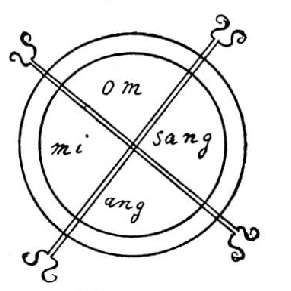
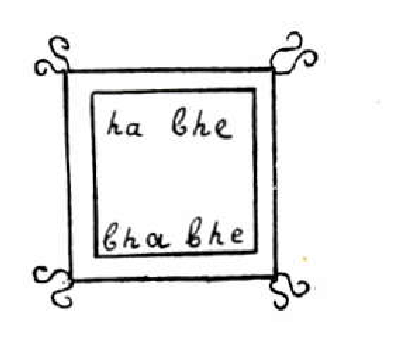
Yantra to protect the vegetable garden
This pattern is drawn on a palm leaf and buried in the soil or hung up in the garden. It protects the garden from animals such as monkeys and pests.
Yantra to bring success in a law suit
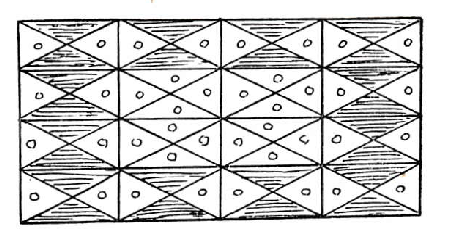
This yantra is more complicated. It must be drawn on a palm leaf that has been partially eaten by worms. The mantra “ Om Sri Muniya. Muniya, jaya pilla, Muniya Esvaha” (Om, majestic Buddha victory Buddha, victory on the spot. Buddha. It is good!) This must be recited as the yantra is placed in an offering stand with 5 kinds of seeds, 7 kinds of white flowers, a little bottle of perfumed water and some lamp oil. The mantra must be repeated 108 times whilst incense and camphor are infused into the offering stand. The yantra is then rolled up and secreted in the litigants loin cloth or pocket. He will then be successful in his lawsuit!
Yantra to bring success in business or profession etc.
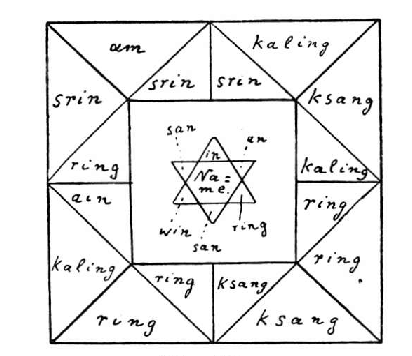
This yantra is drawn on a bijapatri leaf and worn in a little cylindrical case around the neck
Yantra to protect against wild elephants
Wild elephants attacks are a very real danger especially in the rural areas, so these yantra are placed in the belt of the person who is to travel through their areas. The mantra “ Om namo! Patapa. Pralesvaha”(Om glory to Buddha. O majestic one (elephant). It is very good) must be repeated 108 times.
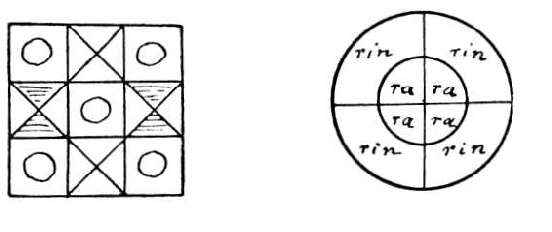
Yantra to protect against enemies

These two yantra are drawn onto palm leaves and placed in a special offering stand with flowers and incense. The special mantra is repeated 108 times. Then the yantra is placed in a metal case and tied to the arm of the person or protection.
The mantra is :
“ Om namo! Sri Akantavi, Kalakandi, Katariri, katu-
Yantra to protect against demons (yakka)
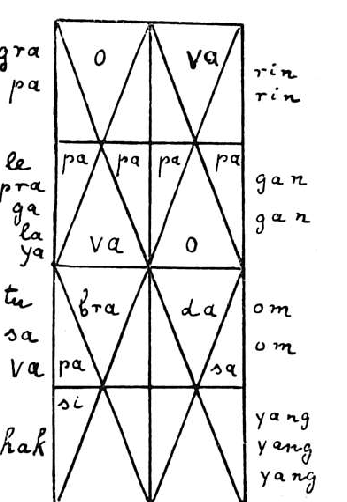
This is one example of a yantra to protect against demons.
An offering stand is arranged with some flowers. The yantra is drawn on a palm leal and laid on a temili nut and dummala is scented around it.
The officiating edura recites the following mantra at the same time:
“Om namo! Raksha, Vishnu-
This gives protection against demons generally but some yantra are to protect against specific demons.
Yantra to give protection against Hiri-
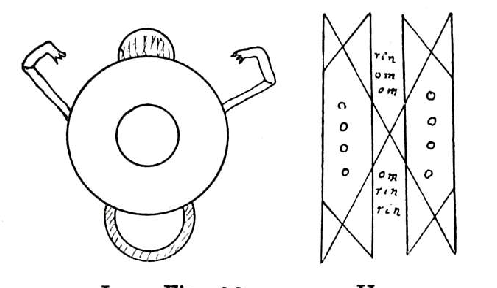
These are drawn on a palm leaf and the two must be used together.
Offerings are placed in the special square shaped offering basket with 4 compartments used for Hiriyakka. The special offerings for Hiriyakka are put in each compartment -
Each yantra is smoked with dummala a special mantra for each yantra is recited 108 times each. This must be done on a Saturday.
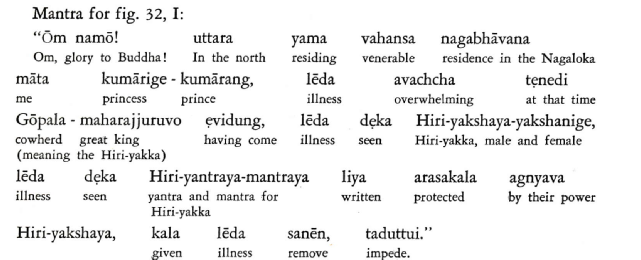
Mantra for the circular yantra:
Mantra for the other yantra:
“Om! asurayak. Esvaha. (Om! A certain asura. It is good)
Namo! Dana Bahirava ehi. Esvaha. (Glory to Buddha, Shiva come. It is good)
Namo! Ahi sidi ehi. Esvaha. (Glory to Buddha! Please appear here. It is good)
Namo! Bandha, bandha. Nesvaha. (Glory to Buddha, bind, bind. It is good)
Namo! Badani -
The yantra are placed in a metal case and placed around the waist. This part must all be performed on a Sunday.
Yantra against the yak-
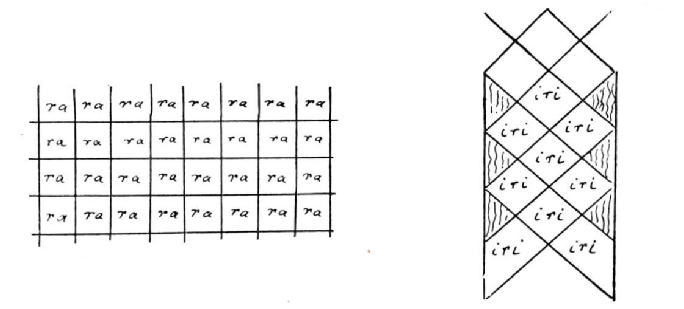
These two yantra are drawn on a palm leaf and placed with flowers in an offering stand. They are then perfumed with dummala and a mantra is recited one hundred and eight times:
"Om namo! Maladola -
Glory to Buddha! former residence of the Hiri-
Hiri-
Then the two yantra are put in a metal case and worn around the waist.

This is the protective yantra drawn on a palm leaf that an edura will fasten to a victim awaiting a toil dance ceremony. This is done when the victim believes they have encountered a demon and then they start talking nonsense and/or behaving out of character e.g. the cow man toil.
Yantra to protect against diseases caused by Patinni
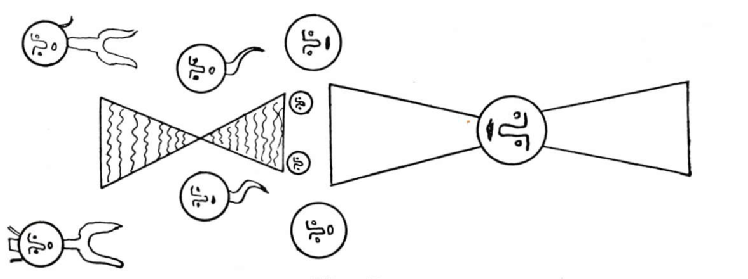
This yantra is drawn on a palm leaf and placed on an offering stand with flower offerings. It is smoked with dummala. Then a mantra is recited over it 21 times:
“Om namo! Teruda, Sanikara masekra muru-
(Glory to Buddha! Teruda (a deity) Saturn forgive great cruelties, forgive cruelties and badness which have bound this body these yantra mantra cleanly King of Hell Ruler of the West, bow , clap ones hands. It is good!)
Yantra and Mantra are numerous. These are just a few examples. They cover numerous illnesses and situations -
Yantra to spoil fishing and drive the fish away
This yantra is drawn on a brick and the fisherman’s name against whom it is directed is incorporated into the design. It is placed in an offering stand with flowers, rice, a piece of sandalwood and a clay oil lamp. Then a mantra is repeated 108 times while dummala is burnt:
“Om ran, tau sadiya kanandu dane tenaje tutistan santudan Buddhanu bahavena Ginapanjera mahaviro eti Sambuddhan prayana mahavidita viditanu yuta mahbala Mahakashyapa, Gautaman, Sariputra, Buddhopi mahatea.”
Then the brick is laid on the shore face down, where the fishermen set off to fish. -
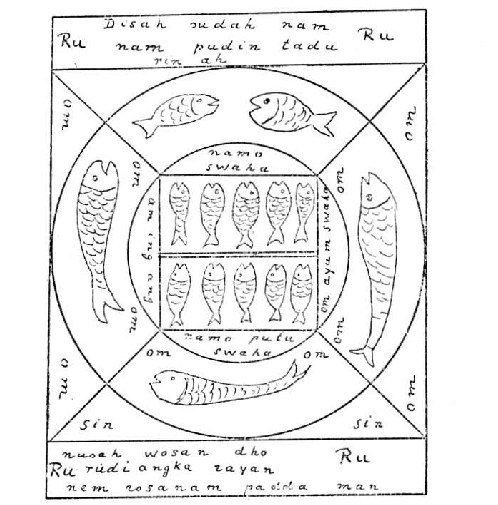
A very evil Yantra and mantra

This is a very evil spell to cause a person or a family serious harm. These 3 yantra are copied onto one side of a brick with a piece of charcoal taken from a recent cremation site. On the other site is written the name of the person to whom harm is intended. Then a mesa is arranged under a bo-
Whilst this evil mantra is being recited the brick is perfumed with dummala. Then it is buried secretly in the garden of the intended victim. This results in the summoned demons throwing stones on the roof of the vitim’s house at night and then the family will become ill one after the other resulting in death if the brick is not quickly found and destroyed.
Yantra to cause illness and death of cattle
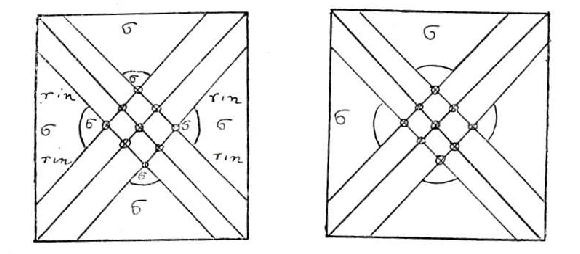
These yantra are drawn on a brick which is placed on an offering stand. Dummala is burnt around this offering whilst the evil mantra is recited 108 times:
“Om namo, Asurapa-
The brick is then buried in the cattle’s grazing place and if it is not found in time and destroyed by dropping the blood of a cock’s cut throat on the site where the brick is buried, the cattle will sicken and die so impoverishing the owner and family.
There are numerous mantra and yantra to cause success in enterprises, good luck etc. etc. but the much darker side is those that are to cause harm to others and enemies due to jealousy revenge etc. These result in sickness of the intended victim or their family, livestock, failing crops, bad luck etc etc.
Thus when a person of his/her enterprises or families suffer any of these symptoms, in this context it can be better understood where devil dancers, eduras, and other traditional healers will be consulted and how they fit into protection and healing in Sri Lanka.
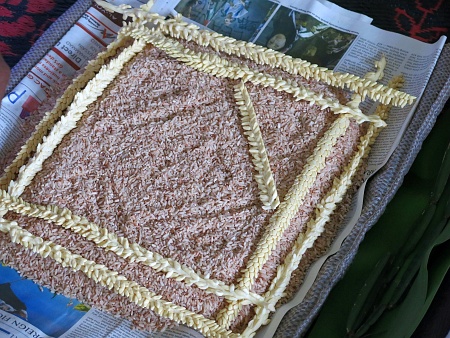
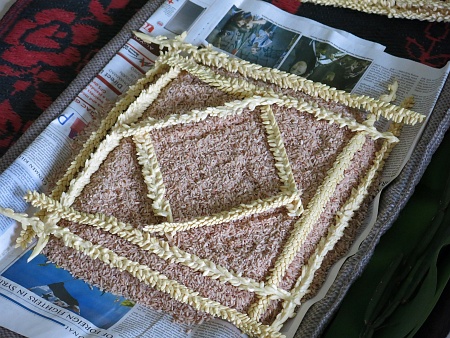
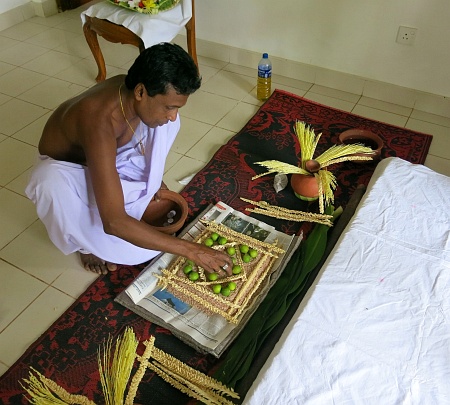
Fig.32.1
(These are just a few extracts of the many examples given by Paul Wirz in “Exorcism and the Art of Healing in Ceylon”. For further examples see pages 206-